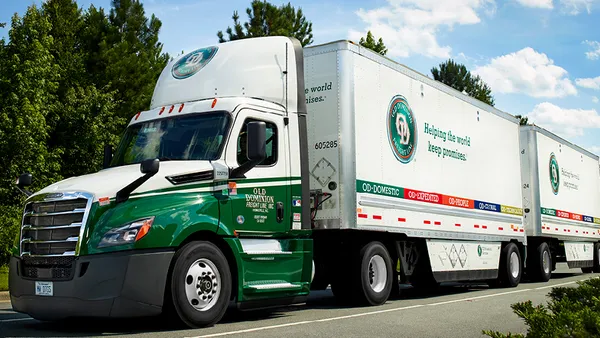Dive Brief:
- NFI and Penske will use electric eCascadia trucks built by Daimler in their operations, the automaker said this week on Twitter.
- Penske will use the trucks in its Southern California network, while NFI will use them in its drayage operations. NFI ordered 10 of the trucks. It's not clear how many Penske ordered.
- "NFI will operate the eCascadia as part of its drayage fleet that runs between the Port of Los Angeles and our 15 million sq. ft. distribution campus in Chino, CA," Bill Bliem, the senior vice president of Fleet Services at NFI, told Supply Chain Dive in an email. "The port operations are perfect for providing feedback on these trucks, and as range and weight capabilities enhance, we intend to expand into other dedicated operations."
Dive Insight:
NFI's test case in drayage is a good candidate for electrification, according to Suzanne Greene, the manager of the Sustainable Supply Chains program at the Massachusetts Institute of Technology (MIT). "Drayage is a good option because they know where their chargers are, they know what their route is," Greene said in an interview with Supply Chain Dive.
Some drayage operations have even looked into the use of overhead catenary wires to power trucks, she said. The kind of equipment being run by carriers and logistics providers is becoming increasingly important for shippers who are making commitments to reduce their carbon footprint throughout their supply chain.
But it can be difficult for shippers to demand carriers use electric fleets. Greene worked with her colleagues at MIT to see if they could negotiate with big logistics providers bringing goods onto campus to use "electric anything," she said. "We couldn't make that happen."
Greene said they're still working on it and offering the status as a preferred carrier to whatever company can make it happen. Some companies were eager to meet the request but not able to say yes.
"When we were doing that, I definitely felt like we were pushing the envelope," she said.
A shipper with more heft in the industry, like Walmart, might have more luck with this kind of demand. But even then, it comes down money. "That is the big question, right?" Greene said. "Who pays?"
U.S.-based shippers interested in picking their carriers based on fuel efficiency can turn to the Environmental Protection Agency's SmartWay tool to see average fleet emissions. Of course, this average isn't going to change much with just a handful of electric vehicles, so a direct conversation with the carrier can be helpful, Greene said.
"When people start asking these questions and asking for electrified trucking then the carriers will move," Greene said. "They want to serve us and make money, but we have to be asking these questions."
These are not the first carriers to start the process of electrifying their California fleets. DHL announced the addition of 63 electric delivery vehicles earlier this year, and the U.S. Postal Service said it was piloting electric cargo vans for routes in Fresno, California.
A lot of this change is currently taking place in California, where regulations likely play a role. The California Air Resources Board has set rules for truck manufacturers requiring a certain percentage of their sales be electric trucks by specific years, according to Trucks. The CARB recently provided one-on-one assistance to truck drivers and fleet owners looking to understand the latest air quality rules and how to comply.














